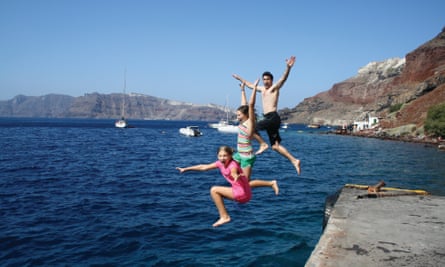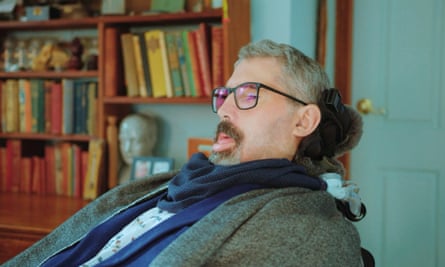Few people who make vows to stay together in sickness and in health give the words a second thought.
For Rachel Yerbury, the promise she exchanged with her husband, Justin, back in 1995 has tested her in ways most couples cannot imagine. Shortly after they married, motor neurone disease started cutting a swathe through his family. His uncle. Cousin. His grandmother, mother and sister. Justin was determined to research the disease, and set about becoming a leading molecular biologist. His work brought him to New York in 2016, a lecture hall filled with the top minds in MND research. As he stood at the lectern to give a speech on his work, his thumb stopped working. The realisation that this was the first sign of MND in his own body hit him like a punch in the face. He thought immediately, “Fuck. How will I tell Rachel?” And then he continued his speech.
With that, Justin became not only MND’s most high-profile crusading researcher – but one of its sufferers.
MND is a rare condition that progressively damages the nervous system, leading to muscle weakness. While the body becomes gradually paralysed, leaving only the eyes and the heart unaffected, the mind remains sharp. The inherited form of the illness that Justin has is the rarest, affecting one in 10 sufferers. There is no cure but the biologist has made significant breakthroughs in understanding the causes of the disease (mutant or damaged proteins in neurons), which last year earned him Australia’s most prestigious prize for science.
Justin and Rachel met at a New Year’s Eve party in 1991 when they were both just 17. He was a tall, socially awkward athlete and she was hoping to become a school psychologist. They shared a love of being in nature, bushwalking and mountain biking. “It felt just right,” Justin writes in Fighting Fate, his memoir, completed despite total paralysis, using eye tracking software.
Today the barely detectable movement of one eye is the only means of communication between Rachel and Justin. And yet from this Rachel manages to include him in conversation as if it were the most normal of partner exchanges, with a “Do you remember that, Justin?” here and a “Can I show … ?” there, as if we were looking at holiday photo albums together. They have been a team for 31 years, during which Rachel says they have never had a fight.

“Annoyance, yes, disagreement yes, but never more than that,” she says, laughing. “Justin does not fight, he sees the bigger picture. When I met him I thought he was a mummy’s boy and needed to toughen up.”
One bone of contention is that she thinks her name should be alongside Justin’s on his book, as he could not have written it without her. She has a point. “I typed it up, I suggested that he include some of his dreams from his diary, and stories he had written for the family. And then I helped with the editing, which was very hard because when it came to all the science content, by then he could only say yes or no to my questions.”
The result, Fighting Fate, is an at times harrowing read, as Justin recounts death by death the numbing toll MND wreaks on his family, and the weight of responsibility he puts on his shoulders to find a cure. There is the dread of waiting for MND, the terror of wondering if his own decline was imminent, and there is the love that sustains him through it.
He writes: “I have lost count of all the times when Rachel has advocated for me, fought for me, protected me, comforted me and saved my life in both a physical and emotional sense.
“Rachel is the hero of my story in so many ways. I wish I could be there for her in the same way. It breaks my heart that I can’t.”
Rachel has written her own memoir, as yet unpublished – her version of a remarkable partnership. As well as revealing her own mounting dread and increasingly frequent nightmares that everyone around her would die of MND, it expands on her personal understanding of how immersion in nature – in her case, preferably swimming with dolphins, a motif that recurs throughout the house and its ocean blue-painted walls – can bring about a unique kind of solace and healing. She has had a long time to prepare for the inevitable.
At 195cm in height, Justin Yerbury is a big presence in his wheelchair. He reclines between us, staring ahead, mouth open, on a ventilator, with Sunny, a toy poodle curled on his lap, chosen because he is light enough not to cause Justin discomfort while helping with temperature regulation.
We are in the lounge room of their suburban home on the outskirts of Wollongong, not far from where Justin was born, went to school and fulfilled his dream of playing professional basketball for the Illawarra Hawks. It is within what used to be easy reach of the department of molecular biology at the University of Wollongong, where he ran a team of 17 doing world-leading, pioneering research into a cure for the disease which has ravaged generations of his family.
It first took the lives of his uncle and cousin, then, in 2002, in the space of six weeks, his mother, aunt and grandmother. His sister Sarah died of it a few years later. “We all had a sense that MND had rounded us up and was picking us off one by one,” he writes.

Rachel apologises that the room needs to be kept dark and cool – dark, because light strains Justin’s already damaged eyes painfully (having lost the ability to close them naturally, he had surgery to insert weights into his eyelids to help him sleep); cool, because the machines on which he depends require it for peak efficiency. There are 10 of them in all, sighing and blinking and puffing and emitting purified air and delivering drugs and doing all the things a healthy body should do on its own but this one, at not yet 50, no longer can. A carer sits in another room watching his heart monitor. “He has to have eyes on him 24 hours a day,” says Rachel, who has had to get used to sharing the family home with a permanent roster of a dozen helpers.
“We have a team leader who coordinates and manages all Justin’s tests, interventions, allied health visitors and admin. In the early days I tried to do it all, when staff from agencies let us down or cancelled, but I can’t do it now. It takes four hours to get Justin up, washed and dressed.”
After a couple of potentially fatal near-misses, local energy providers know that this house cannot afford a power cut under any circumstances and have a bypass arrangement in place. There is also a back-up generator on site for emergencies. Nothing is left to chance.
“We used to listen to music but now I need the house to be quiet so I can hear the slightest gurgle or alarm from his heart monitor,” says Rachel, whose two daughters and their partners live nearby. “We are always on edge, hyper-vigilant.”
Some of the equipment Justin depends on is beginning to fail, and is hard to replace. The Yerburys had to fight hard for his electric wheelchair, valued at $30,000, because “initially the NDIS did not believe he would live long enough to justify the cost”. (The average life span after an MND diagnosis is 27 months. Stephen Hawking, whom the Yerburys met while Justin was doing research in Cambridge, lived for more than five decades with the disease.) Justin has lived for seven years since being diagnosed.
Rachel was not always the stoic she is today. When Justin had his suspicions and fears confirmed by diagnosis, Rachel says she “howled like an animal. I keened. That lasted two years. Then I learned to compartmentalise. I could keep it together at work.” There have been counsellors to assist, “but actually writing my memoir is what has helped me the most, which is why I’m calling it Accepting Fate,” she says, laughing at the bitter irony of their contrasting titles. Somehow, amid all this, she managed to complete a PhD in psychology. Meanwhile, Justin was awarded Australian science’s highest award, the Eureka prize, last yar.

After Justin was diagnosed, the family travelled a lot to build up a memory bank of special places and shared adventures – a safari in Africa, seeing the northern lights in Scandinavia, swimming with whales. Justin continued to ride his mountain bike, defying doctors orders for as long as possible. The couple have been watching Tim Winton’s series on Ningaloo on ABC TV. “When we watch shows like Back to Nature… Justin’s heart rate would drop,” Rachel says. “It has the same effect as meditation.”
“I’ve made peace with the situation,” says Rachel, looking directly at Justin as she speaks. Everything the couple have needed to say to each other has been said.
There will be no launch event for the book, no public celebration of its publication, but the consolation that Justin knows that Fighting Fate is out in the world, spreading his message that a cure is within reach, even if not in time for him.

